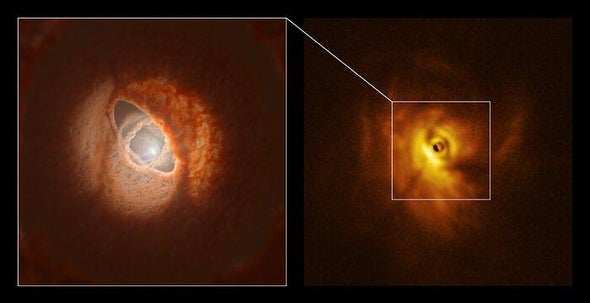(单词翻译:单击)
听力文本
This is Scientific American's 60-second Science, I'm Christopher Intagliata.
Our solar system is far from the only way to put together stars and their planets.
"If you look at all the stars, you know, in our galaxy, in the Milky Way, right? More than half of the stars are formed in multiples—meaning there's more than one star in the system."
Astrophysicist Jaehan Bae of the Carnegie Institution for Science. He has studied one of those systems—with three stars. It's called GW Orionis. And it's freshly formed—only a million years old.
"Yeah, it's really, really young. Yeah, it's a baby."
Bae says if you translate that million-year life span to that of a human, it's the equivalent of a week-old baby. And how many week-old babies do you bump into?
"So if you just walk around your neighborhood, there's little chance you meet a baby who's one week old, right? So, first of all, it's hard to find these systems—they're pretty rare."
Bae and his colleagues got lucky spotting this one. Using radio telescopes, they were able to image the star system. And they say it differs from our own solar system in more than just star count.

In our solar system, for example, all eight planets orbit the sun more or less in a single plane. Think of the sun as the center of a vinyl record—with the planets strung out along the grooves.
In contrast, Bae's team discovered that the stars in this triple-star system are ringed by clouds of dust in multiple warped and misaligned planes—picture a three-dimensional gyroscope rather than a two-dimensional vinyl record. The observations are in the journal Science.
Those rings of dust will presumably go on to form planets as the star system matures. And Bae says astronomers have indeed observed other, more mature star systems—with planets orbiting in these misaligned planes.
"And we wanted to understand if that happens when the planets are born or whether it's some evolutionary thing that happens over, you know, a billion years."
The finding suggests that weirdly aligned planetary systems are born that way—and that stars and their embryonic planets can be all topsy-turvy—even in their infancy.
Thanks for listening for Scientific American's 60-second Science. I'm Christopher Intagliata.
参考译文
这里是科学美国人——60秒科学系列,我是克里斯托弗·因塔格里塔。
我们的太阳系远非将恒星及其行星组合在一起的唯一途径。
“如果你观察我们银河系中的所有恒星。超过一半的恒星由多个组成,这意味着星系中有不止一颗恒星。”
卡内基科学研究所的天体物理学家杰汉·贝说到。他研究了一个由三颗恒星组成的星系。这个星系名为GW Orionis。它是新形成的,只有100万年的历史。
“是的,它真的很年轻。还是个婴儿。”
贝表示,如果将100万年的生命转换成人类的寿命,那相当于一周大的婴儿。你会碰到多少个一周大的婴儿?
“如果你只是在附近走走,你几乎不可能遇到一周大的婴儿。因此,首先,很难找到这些系统——它们非常罕见。”
贝和同事幸运地找到了一个星系。利用射电望远镜,他们能够成像这个星系。他们表示,它与我们太阳系的区别不仅仅在于恒星数量。
例如,在我们的太阳系中,所有八颗行星或多或少都在一个平面上围绕太阳运行。将太阳想象成一张黑胶唱片的中心,行星沿着凹槽排列。
相比之下,贝的研究小组发现,这个三星系中的恒星在多个扭曲和错位的平面上被尘埃云环绕,想象一下三维陀螺仪,而不是二维黑胶唱片。这些观察结果发表在《科学》期刊上。
随着恒星系统的成熟,这些尘埃环可能会继续形成行星。贝表示,天文学家确实观察到了其他更成熟的恒星系统,行星在这些错位的平面上运行。
“我们想知道这是在行星诞生时发生的,还是在10亿年间的富甲天下过程发生的。”
研究结果表明,排列奇怪的行星系统诞生时就是如此,恒星和它们的胚胎行星可能都是乱七八糟的,甚至在婴儿期也是如此。
谢谢大家收听科学美国人——60秒科学。我是克里斯托弗·因塔利亚塔。
译文为可可英语翻译,未经授权请勿转载!
重点讲解
重点讲解:
1. be far from (用于加强否定)远非如此,绝非这样;
Research on the matter is far from conclusive.
对这一问题的研究还远远没有定论。
2. bump into 偶然遇见;意外碰到;
I happened to bump into Mervyn Johns in the hallway.
我在走廊里意外碰见了默文·约翰斯。
3. more or less 或多或少;大概;几乎;
It more or less gets the thumbs up from everyone.
它多多少少得到了每个人的支持。
4. in contrast 相比之下;与…相反;
In contrast, the lives of girls in well-to-do families were often very sheltered.
相反,生活在富裕家庭的女孩子通常都备受呵护。
关注微信公众号【可可双语精读】,获取详细讲解内容


